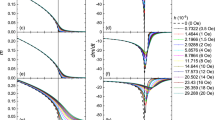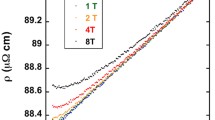Abstract
It has been pointed out recently by one of us (M.S.R.C.) that the variation of the Kondo slopesd (of the ρ/c vs. lnT curves) of dilute magnetic alloys containing a finite solute concentrationc bears a close resemblance to the variation of the functionf (=cos6 ν cos2ν) with the phase shift ν for ordinary spin-independent scattering. Sinced is itself primarily determined byf the inference is that ν is a function ofc when the criterion of infinite dilution is violated. For infinite dilutions theory expects the anomalous thermoelectric power in such alloys to be independent ofc as well as ofT. Taking the experimentally observed extremum in the TEP (S m) as an approximation to such a TEP, we report, for finite solute concentrations, the variation ofS m withc, to correspond with the variation off′(=cos6 ν sin2ν) with ν. This substantiates the above inference. In fact, one can predict the sign and the variation (withc) ofd, knowing that ofS m, and vice versa, for a given dilute magnetic alloy system.
Similar content being viewed by others
References
G. J. Van den Berg,Progr. Low Temp. Phys. 4, 194 (1964).
M. D. Daybell and W. A. Steyert,Rev. Mod. Phys. 40, 380 (1968).
J. Kondo,Progr. Theoret. Phys. (Kyoto)32, 37 (1964).
J. Kondo,Progr. Theoret. Phys. (Kyoto)34, 372 (1965).
D. K. C. MacDonald, W. B. Pearson, and I. M. Templeton,Proc. Roy. Soc. (London)A266, 161 (1962).
A. Kjekshus and W. B. Pearson,Can. J. Phys. 40, 98 (1962).
K. Fischer,Phys. Rev. 158, 613 (1967).
M. S. R. Chari,Phys. Kondensierten Materie 11, 317 (1970).
P. G. De Gennes,J. Phys. Radium 23, 630 (1962);Metallic Solid Solutions, J. Friedel and A. Guiner, eds. (W. A. Benjamin, New York, 1963), paper VI.
K. Yosida,Phys. Rev. 107, 396 (1957).
Y. Nagaoka,Progr. Theoret. Phys. (Kyoto)39, 533 (1968).
H. Suhl,Phys. Rev. 141, 483 (1966);Physics 2, 39 (1965).
K. Fischer,J. Phys. Chem. Solids 30, 539 (1969).
J. Kondo,Phys. Rev. 169, 437 (1968).
R. W. Schmitt and I. S. Jacobs,J. Phys. Chem. Solids 3, 324 (1957).
A. N. Gerritsen and J. O. Linde,Physica 18, 877 (1952).
J. S. Kouvel,J. Phys. Chem. Solids 21, 57 (1961).
N. S. Natarajan and M. S. R. Chari, unpublished data.
H. L. Malm and S. B. Woods,Can. J. Phys. 44, 2293 (1966).
A. N. Gerritsen and J. O. Linde,Physica 17, 573 (1951).
W. H. Keesom and C. J. Matthijs,Physica,2, 623 (1935).
S. Tanuma,J. Phys. Soc. (Japan)14, 541 (1959).
B. Caroli,J. Phys. Chem. Solids 28, 1427 (1967).
P. Costa-Ribeiro, J. Souletie, and D. Thoulouze,Phys. Rev. Letters 24, 900 (1970).
J. W. Loram, P. J. Ford, and T. E. Whall,J. Phys. Chem. Solids 31, 763 (1970).
R. Tournier and A. Blandin,Phys. Rev. Letters 24, 397 (1970).
A. N. Gerritsen,Physica 25, 489 (1959).
G. J. Van den Berg, J. Van Herk, and B. Knook,Proc. 10th Int. Conf. on Low Temp. Physics (Moscow, 1966), Vol. 4, p. 272.
C. Domenicali and E. L. Christenson,J. Appl. Phys. 32, 2450 (1961).
B. R. Coles,Phys. Letters 8, 243 (1964).
H. Nagasawa,J. Phys. Soc. (Japan)25, 691 (1968).
K. Kume,J. Phys. Soc. (Japan)22, 1116 (1967).
K. Kume,J. Phys. Soc. (Japan)22, 1309 (1967).
H. Suhl and D. Wong,Physics 3, 17 (1967).
K. Kume,J. Phys. Soc. (Japan)23, 1226 (1967).
K. Kume,J. Phys. Soc. (Japan)22, 1115 (1967).
M. D. Daybell, D. L. Kohlstedt, and W. A. Steyert,Solid State Commun. 5, 871 (1967).
E. Brewig, W. Kierspe, U. Schotte, and D. Wagner,J. Phys. Chem. Solids 30, 483 (1969).
H. Eicke and H. D. Hahlbohm,Z. Metallk. 55, 524 (1964).
W. Kierspe,Z. Metallk. 58, 895 (1967).
K. Kume and O. Kogure,J. Phys. Soc. (Japan)25, 930 (1968).
N. F. Mott and H. S. W. MasseyTheory of Atomic Collisions (Cambridge University Press, New York, 1965), p. 30.
See, for example, R. M. Eisberg,Fundamentals of Modern Physics (John Wiley & Sons, New York, 1961), p. 545.
Author information
Authors and Affiliations
Rights and permissions
About this article
Cite this article
Chari, M.S.R., Natarajan, N.S. & Sharma, R.G. Concentration dependence of the anomalous thermoelectric power of dilute magnetic alloys. J Low Temp Phys 4, 503–513 (1971). https://doi.org/10.1007/BF00631129
Received:
Issue Date:
DOI: https://doi.org/10.1007/BF00631129




